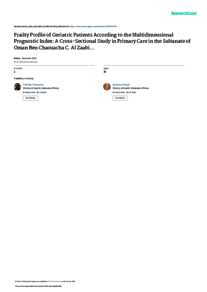وثيقة
Frailty profile of geriatric patients according to the multidimensional prognostic index : a cross-sectional study in primary care in the sultanate of Oman.
المعرف
DOI: 10.33879/AMH.134.2022.02020
المصدر
Aging Medicine and Healthcare. v 13, 4, p. 184-192
المساهمون
الدولة
uni
مكان النشر
Boston
الناشر
Full Universe Integrated Marketing Limited.
ميلادي
2022-12-01
اللغة
الأنجليزية
الموضوع
الملخص الإنجليزي
Background/Purpose: To determine the prevalence of frailty and describe the association of socio-demographic characteristics and clinical aspects with frailty among the Omani geriatric population attending primary care settings. Methods: We conducted a descriptive cross-sectional study from April to June 2021 that included 197 older adults aged ≥65 years (mean age 72.8±6.8 years, 61.9% female) attending Wadi Maawil primary healthcare center, South Batina. Frailty profiles were categorized using the Multidimensional Prognostic Index (MPI). Frailty determinants were defined on the bases of socio-demographic and clinical characteristics of the study population, in addition to the MPI domains. The contribution of frailty determinants to frailty status was explored using bivariate and multinomial regression analyses. Results: The prevalence of pre-frailty and frailty was 12.7% and 31.5%, respectively. The overall mean MPI score was 0.35±0.20. Pre-frailty and frailty were strongly associated with older age (OR=4.49, 95% CI=0.86–23.5 and OR=2.91, 95% CI=0.75–11.2, respectively) and female gender (OR=2.88, 95% CI=1.37–6.05 and OR=3.45, CI 95%=1.21–9.87, respectively). Cardiovascular diseases, type 2 diabetes mellitus, comorbidity, polypharmacy, functional disability, and malnutrition were the most important determining factors for frailty. Living with the family was found to be a protective factor. Conclusion: Frailty and pre-frailty were prevalent among older adults attending a primary care setting. Screening for frailty using a multidimensional approach is crucial to identify modifiable contributing factors to establish appropriate interventions and for guided decision-making, thus preventing negative health outcomes.
ISSN
2663-8851
قالب العنصر
مقالات الدوريات

